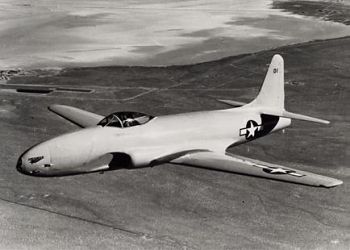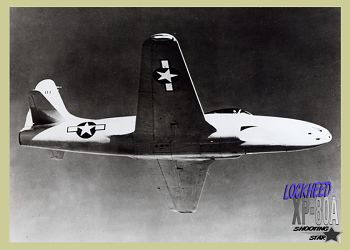
 |
Once design work on the XP-80 (known internally as the L-140) had progressed to the point of near-completion, Johnson secured a contract to build two pre-production prototypes. Known within Lockheed as the L-141, they received the military designation XP-80A. The first XP-80A (44-83021) was virtually complete by 3 June 1944. It was painted light gray, earning it the nickname of Gray Ghost. The airplane was trucked from Burbank to the Muroc Flight Test Base near the north end of Rogers Dry Lake early on the morning of 4 June. For security reasons it was completely covered by a tarp and accompanied by a police escort.
After technicians completed the final assembly and checks, Lockheed test pilot Tony LeVier began taxi tests on the lakebed. On a few high-speed taxi runs the airplane hopped a foot or two off the ground.
 |
Technicians spent several days inspecting the airplane and making corrections. Following adjustments to the engine and placement of ballast to move the center-of-gravity, LeVier accomplished a second test flight with almost no problems. Unfortunately hot air was still blowing into the cockpit. Changes to a faulty control valve solved the problem.
In late 1944 the Army pilots visited Muroc to fly the Gray Ghost and Lulubelle in mock combat against such front-line fighters as the P-38, P-47, and P-51 and various bombers. The secret tests were designed to find out what tactical formations, if any, could be used against the German jets then being seen in combat over Europe. The jets bested the propeller-driven planes every time. The results of the exercise made production of American jet fighters all the more urgent to counter the German threat.
Testing of the XP-80A continued and LeVier discovered a phenomenon that came to be known as duct rumble. The cause was eventually traced to uneven airflow at high speeds and low engine revolutions-per-minute (rpm) that created turbulent flow inside the intake ducts at the fuselage wall. Lockheed engineers had to develop a bypass to bleed the troublesome air above and below the wing.
A number of design problems were discovered with the XP-80A. Although many of them were corrected, the Gray Ghost was to have a short career.
